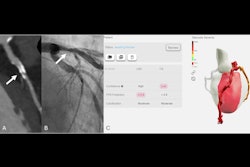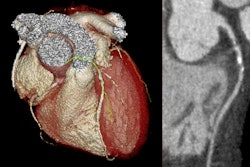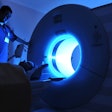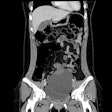CT-derived fractional flow reserve (CT-FFR) and CT myocardial perfusion imaging boost the specificity of coronary CT angiography (CCTA) for ruling out coronary artery disease (CAD) -- and perform comparably to CCTA alone.
The study findings highlight alternative options for CAD assessment, wrote a team led by Dr. Martin Soschynski of the University of Freiburg in Germany. The group's research results were published on 20 August in Radiology.
"CCTA plus CT-FFR and CCTA plus CT perfusion showed no evidence of a difference in diagnostic accuracy metrics for detecting hemodynamically relevant CAD," the authors reported.
CT-FFR and CT perfusion have been shown to boost CCTA's specificity when it comes to ruling out CAD, but how the three techniques compare in diagnostic performance has remained unclear, Soschynski and colleagues noted. To address the question, they compared the diagnostic accuracy of CCTA plus CT-FFR; CCTA plus CT perfusion; and sequential CCTA plus CT-FFR and CT perfusion to CCTA alone for detecting "hemodynamically relevant" CAD (defined as patients having at least one coronary stenosis with an invasive FFR of 0.80 or less, or angiographic stenosis greater than 90% at CCTA) via a study that included 105 patients with chest pain referred for CCTA between July 2016 and September 2019. CCTA alone served as the reference standard.
Of the 105 patients, 47% had hemodynamically relevant stenoses at invasive coronary angiography, the investigators reported. They found that the alternative CT imaging techniques performed comparably to CCTA alone, with only specificity showing statistical significance.
| Comparison of CT imaging techniques to assess hemodynamically relevant CAD | ||||
|---|---|---|---|---|
| Measure | CCTA alone | CCTA plus CT perfusion | CCTA plus CT-FFR | Sequential CCTA plus CT-FFR and CT perfusion |
| Sensitivity | 94% | 90% | 90% | 88% |
| Specificity | 54% | 79% | 77% | 88% |
| Positive predictive value | 64% | 79% | 77% | 86% |
| Negative predictive value | 91% | 90% | 90% | 89% |
| Accuracy | 72% | 84% | 83% | 88% |
"There was no evidence of a difference in diagnostic accuracy between CCTA plus CT-FFR and CCTA plus CT perfusion for detecting hemodynamically relevant CAD … [although the] sequential approach combining CCTA plus CT-FFR with CT perfusion led to improved … specificity with no evidence of a difference in sensitivity compared with CCTA plus CT-FFR," the group reported.
Slide courtesy of the RSNA.
The study results represent significant progress in assessing CAD, according to an accompanying commentary written by Prof. Valentin Sinitsyn, PhD, of the University Medical Center Moscow Lomonosov State University in Russia.
"[The] study … looks like a big step forward in helping select the optimal strategy for the evaluation and analysis of intermediate coronary stenosis," he wrote. "For the majority of patients with suspected CAD, it appears that a combination of CCTA and CT-FFR is the preferable option."
The complete report can be found here.




















